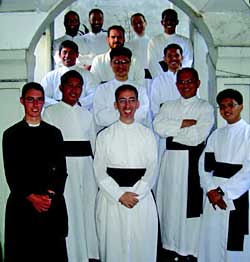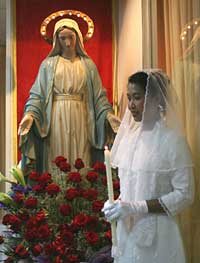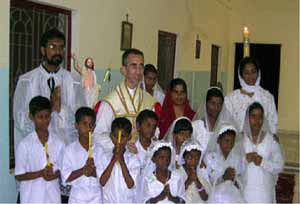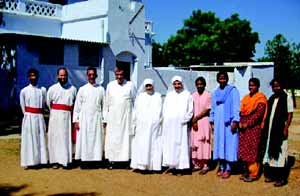

![]()
![]()
|
Newsletter of the District of Asia Jan - April 2007 Interview
with Fr. Daniel Couture,
Chr: Father, you have been in Asia for more than 10 years, and you will soon be reaching the end of a second term of office in this continent where over half of the world's population is living. You seem to like the missionary life…
DC: Missionary is the right word. In the SSPX, we, the spiritual sons of Archbishop Lefebvre, are all, in fact, missionaries: no matter where we are sent, we always find ourselves in a mission country. However, some of our Districts are such in the more classical meaning of the word, if I may say so. Africa and Asia have always more specifically called to mind the missionary adventure. Chr: To how many countries in Asia does the SSPX minister? DC: Presently, the countries which we visit on a regular basis, let’s say at least every other month, are the following, going from west to east: India, Sri Lanka, Indonesia, Singapore, Malaysia, China (which we reach by going to Hong Kong), the Philippines, Japan, South Korea, New Zealand and New Caledonia. Those we visit occasionally are: Thailand, Vietnam, and Taiwan. So, our 17 priests from their four priories manage to keep up the good fight for the Faith on this immense territory. They continue to water with divine grace these few thousands souls whom God is watching and whom He has entrusted to our cares. Chr: What strikes you most when you travel through countries so different in their histories, languages, cultures, and religions? DC: I believe it is the mystery of divine grace which reaches souls in so many different environments. To see everywhere the same fruits of the Holy Ghost, the same thirst for God and the sacraments, and especially for the traditional Mass, and the same love for the Blessed Virgin, fills us with admiration. It is truly a perfect application of the divine word:“I will have mercy on whom I will have mercy,” God tells us (Rom. 9:15) . I also saw this paradox in these countries of the East: on the one hand, we come into contact with paganism, let us say, in its purest state, just as we can find it when we read the lives of the missionaries of the past centuries. We see people who adore stones, devils, and idols of all kinds. And on the other hand, we still find those natural virtues that we have lost in our own Catholic countries. For instance, family virtues, respect for the elders (in many Asian languages, there are different names for your relatives – brothers, sisters, uncles, and aunts – according as they are older or younger) In India and in Sri Lanka, which are Hindu and Buddhist countries, a young lady can hardly get married if she has lost her virginity. There is not as much promiscuity as in our Western countries. Chr: How is Catholic Tradition received in Conciliar circles in the East? DC: It is received with difficulty, for obedience to authority is also a very natural virtue. However, grace is at work here as elsewhere. Well-disposed souls, troubled by what they see in their parishes in the field of inculturation or modernism, understand that obedience is at the service of Faith and not the other way around. Chr: In Asia, apart from the SSPX, are there other traditional Masses offered? DC: Very, very few. As far as I know, in all of Asia, there are Indult Masses only in Bombay (India), in Hong Kong and one or two in the Philippines, and that is all. Recently, I came across an article favorable to Tradition and written by a Vicar General in Vietnam. It would be interesting to follow this up. If the Motu Proprio on the Mass were published, several bishops would certainly encourage the traditional Mass in some of our Asian countries. They are not all as fiercely opposed to Tradition as the bishops in Europe or in the Americas.
Chr: What are the most promising places in the District? DC: The priory with the most complete apostolate is unquestionably in Wanganui, New Zealand. It has a school with 130 students, 6 teaching Dominican Sisters (a local foundation), three priests and some 400 to 500 faithful. And people keep moving from various parts of the country to come closer to this center of intense spiritual life. Next, I would say, are the Philippines, which are a breeding ground for vocations. In the other missions, we are really using the ’fishing rod technique’, we gain souls one by one. Chr: It is true that we meet more and more Asian faces in several communities of Tradition… DC: Deo Gratias! As a matter of fact, we have some in France, in Morgon (Capuchins), in Bellaigue (Benedictine monks); in Italy in Velletri and Vigne (two communities of Sisters) ; and in the SSPX among our Sisters, Oblates, Brothers and priests. The harvest will always be plentiful and the harvesters will always be too few. Oremus! Let us pray! Chr: According to you, what is the precise role of the Society in the East? DC: First of all, it is to safeguard Catholic Tradition by safeguarding the Mass. But we must not forget that the first purpose of the SSPX is “the priesthood and all that pertains to it; all that complements it” (SSPX Statutes). Consequently, we are particularly interested in priestly formation, as everybody knows. By safeguarding priestly formation, we help the universal Church. For, as the Council of Trent teaches in its Catechism, the priesthood is the sacrament most necessary for the whole Church. Hence, as soon as an opportunity arises, we like to get information on the state of the diocesan seminaries in our mission countries -—which we have been able to do a few times— to see what we can do. What did we find out? A real tragedy, like in the West, but at another level. For instance, some time ago, I met the Rector of the only seminary in Thailand. There is only one seminary in this country, which numbers 10 dioceses. They have over a hundred seminarians. I went to see him, among other reasons, to try to find some classic books in Thai, like the Summa of St. Thomas, the Catechism of the Council of Trent, the encyclicals of the popes prior to Vatican II, to begin only with these basic texts. There was nothing, absolutely nothing in Thai. “These books have never been translated,” the Rector told me. The reason is that before the Council, the seminarians would learn Latin, and thanks to Latin they had access to all the books of formation. But with the loss of Latin, it was not only the liturgy that suffered: They have thrown out of the window the key to all (or almost all) of the Catholic library! Besides, these young seminarians know no other modern language. In this way, they are truly cut off from the whole of Tradition. I said as much to the Rector: “Don’t you think that your seminarians, after seven years of formation will have a, let’s say, schismatic mentality? Because they will be cut off from all of the past of the Church…” He did not answer. Schism does exist in the Church, and it is certainly there. I found out the same thing in Vietnam when talking to a professor of moral theology. They no longer have any handbooks, they must rewrite all their courses with modern authors. And this is precisely what Pope Pius XI feared. He could see very clearly the consequences of the loss of Latin for the clergy. On August 1, 1922, he wrote a very strong letter on this subject in which he warned that when the young clergy does not have a sufficient knowledge of Latin, “they neglect the rich volumes of the Fathers and Doctors of the Church, in which the dogmas of the Faith are taught with precision and irrefutably defended, and they rather seek among modern authors a source of doctrine all of their own. These authors not only lack precision in their language and argumentation (note: this recalls an important intervention of Archbishop Lefebvre at the Council!) but they also fail to expose the doctrine faithfully.” Personally, I think that the SSPX in Asia as well as in the rest of the world, is only in its first stage with the safeguard of the Mass and of the doctrine. A second stage will be assistance to priests in great numbers; and then, with God’s grace, the founding of numerous seminaries in the whole world, as, for instance, the Sulpicians (whom we find in Vietnam) did.. Or at least the SSPX would collaborate with the bishops to open seminaries. Archbishop Lefebvre, during the Easter retreat in Ecône, in 1984, even considered a model seminary in Rome one day! We will see, if we live long enough!
India: Several orphans after their baptism Chr: How is Thomism received in Asia? DC: This is a good question. At the Asian Synod in 1998, several interventions were made against Western, namely scholastic of course, philosophy and theology. The most rabid in this sense were the Japanese bishops. (I learned afterwards that the texts of those interventions had been prepared by Italian Jesuits!) So, as a rule, we rather often meet with an attitude hostile to St. Thomas, under the pretext that he comes from the West. However, I met an old bishop, who was very well versed in Latin and Greek culture, and who would have liked to marry Eastern and Western philosophies. But God, Who counts the drops of water and the grains of sand, and Who has ordered all things in measure, and number, and weight, is certainly not born by chance in Palestine. Neither is it by chance that He willed His Church to use the Greek philosophy, purified and then baptized by St. Thomas. And it is not by chance that He established the see of Peter in the very heart of the Roman Empire. These are data provided by history and to which we must submit. We always come back to St. Pius X who saw in the loss of Thomism the first step towards modernism, and in Thomism the first remedy against modernism. Chr: What about inculturation? Is it a superficial problem or a root problem?
Statue
of Christ doing yoga. This is actually a monstrance.
Chr: Fideliter (the magazine of the French SSPX district) recently published an article about an orphanage in India, which came over to Tradition. Can you tell us more about it? DC: It is one of the most beautiful stories of confidence in Divine Providence I witnessed in all my years as a priest. We saw this young lady, Swarna, discover Tradition, and leave everything, like Abraham, however not with 75 persons like the Patriarch, but with half of that, namely 37 : 20 orphans, 10 elderly persons, and 6 other persons. She left the property she had just bought to build her orphanage (the contract for the construction was to be signed 2 days later). She traveled 22 hours by train to go to another Indian state, where a different language is spoken. And all that in order to be closer to the traditional Holy Mass and the sacraments, and to have a spiritual life strengthened by the catechism classes and conferences given by the SSPX priests. Thanks to this move, she is now making ready to leave all her work in the hands of her helpers in order to consecrate herself to God in the religious life. The Consolers of the Sacred Heart in Vigne, North of Rome, will adopt this beautiful work. These Sisters joined Tradition a few years back, thanks to the good work of Fr. du Chalard. I had the happiness of baptizing most of these 20 orphans and some of the elderly people, among them a Brahmin. They are very beautiful souls quite capable of attracting missionary vocations! Swarna has just bought another property of about 5 acres on which (after her novitiate in Italy) she will build the orphanage, the convent for the Sisters, and, with God’s help, the house of the novitiate, for we expect that this work will attract vocations. As a matter of fact, three young ladies already live at the orphanage, and another impatiently waits for the end of her studies to go and join them. They all aspire to the same religious life. St. Ignatius rightly said: “Few souls know what God could do with them if they did not raise obstacles.” The story of Swarna looks like it is going to be the story of one of those beautiful but rare choice soul.
Visit
of the Consolers of the Sacred Heart to Swarn's orphanage.
DC: In this respect we are certainly lagging behind in Asia, though with New Zealand (and its elementary and secondary school) we are making progress. Last year we opened a small primary school in India for our orphans. But one day we must have a secondary school at least in the Philippines and in India. However, to open a school, we first need parents who are convinced of its necessity. Now, too many, alas, still trust the Novus Ordo schools. And we need money… In some of our poorest chapels, a Sunday collection for 100 people can reach the amount of … US$13 or US$26… We cannot rely on them to get a school working, pay salaries, and so on. I once counted the Sunday collection in one of our villages in India. For 70-80 people there were 17 rupees (US$0.30) and … one egg in the little wicker basket!
Primary School in Wanganui, New Zealand Chr: Apart from schools what are the projects already underway, or planned for the future? DC: We are now at the building stage for chapels Presently we build chapels at the rhythm of one or two each year. The Filipinos are completing their fourth chapel, in India they are about to begin their 3rd. In Singapore, a little city-republic of 4 million inhabitants, a super-rich city, after beginning the Mass center in a private home in the 90’s, we opened the priory, seat of the District in a small rented apartment of 5000 ft2 in 1999. We are looking for a bigger place and even for a abandoned church, but such are not to be found around here! Besides, prices are sky-high: in 1996, a 1-acre plot of land destined for a church, and in which we were interested, sold for over 5 million US dollars… And that was only for the land. The price of a chapel would fetch about as much. But we must not lose hope… Quite recently, a benefactor offered to us a rather unique proposal: he will meet the amount given by the faithful, dollar for dollar up to US $ 100,000 until July 1, 2007 for our Asian missions in general and for this project more specially. This would already be a good start, either to find a better place to rent (and hence for the remodeling to be done), or for a down-payment in case we find something to buy. May St Joseph and St Rita help us! Chr: Is there one last thing you would like to tell our readers? DC: You really have to live in these countries which are sometimes up to 99% pagan to realize the special value of three of God’s gifts: 1- the gift of the Catholic Faith! We too often take it for granted. But it really is a gift from Heaven, which we can lose if we are unfaithful. 2- The gift of the Traditional Mass, which is really Catholic, universal, which reaches the souls of all walks of life, languages and cultures. And lastly… 3- The gift of the Catholic priesthood, and hence of Archbishop Lefebvre’s work to safeguard this priesthood. You must see the love that souls have for the priest, especially when he comes only every 3 or 4 months. So, let us not be ungrateful but, on the contrary, let us appreciate as much as possible these treasures of our holy Roman Catholic Faith. To help the Missions of the SSPX in Asia, please visit here. |





